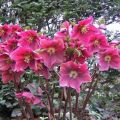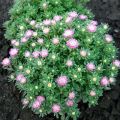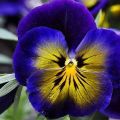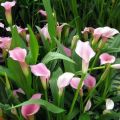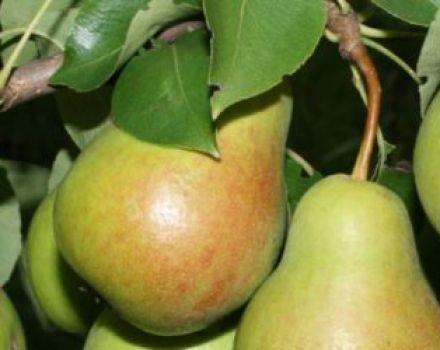Description of 20 varieties and types of perennial helenium, planting and care in the open field
Gelenium is a perennial herb. It is widely used in gardening for landscaping. Shoots reach a height of 2 meters, blooms during the summer. Forms bright yellow, orange, red flowers of large size. They decorate the garden beds and go well with other flowering plants.
Description and features
Gelenium is a perennial plant, reaching a height of up to 120 cm. Forms high erect stems with green lanceolate leaves. Flowering begins in June and lasts until September, the flowering time depends on the variety. Large flowers are formed with a diameter of 6-8 cm.The color varies from bright yellow to bright red. Gelenium resembles large daisies. A feature of the plant is that the bush is formed from separately growing shoots with intertwined roots.
Growing through open ground
To grow helenium in the open field, choose a suitable place, soil, observe the planting time and planting technique.
Seat selection
The plant loves good sunny areas. In shaded places, it gives not such lush flowers, the stems are pulled towards the sun, the bush grows unevenly. Gelenium does not like drafts and increased moisture.
Ground requirements
The crop prefers light, airy soil with good drainage. The plant is difficult to tolerate frequent flooding by rain and melt water. The roots are prone to decay, and the bushes die.
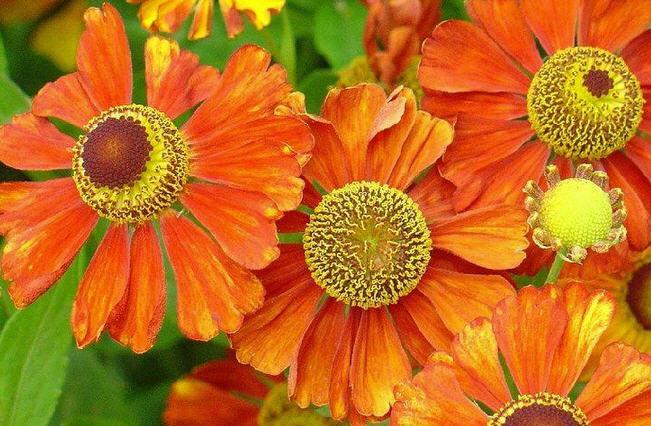
Timing
The plant is planted in open ground in mid-May or earlier, depending on the region. At the time of planting, the soil should warm up to 10 ° C at 10 cm depth.
How to plant
Wells for planting are formed on the site. The distance between them should be 40-80 cm, depending on the type of helenium. For undersized species, they maintain a distance of 40 cm, for medium-sized ones - 60 cm, for tall ones - 80 cm.
Planting is carried out according to the following algorithm:
- Dig holes 20 cm deep.
- A drainage composition is laid at the bottom of the hole.
- Then soil is poured, filling half of the hole.
- Pour warm water.
- The plant is transferred to the hole.
- Sprinkle the roots layer by layer, compacting each layer.

How to grow and plant seedlings
Seedlings are grown using seeds. The grains are harvested from the mother bush or bought in flower shops. Gelenium hybrid varieties will not produce the same flowers from harvested seeds, so they can only be purchased.
Timing
Seedling preparation begins in April. At this time, the first frosts had not yet receded. 2-3 weeks after planting, the grains will sprout, which require appropriate care.
Seedlings are ready for planting, usually in mid-June.
Seed preparation
The seeds are soaked in warm water for a couple of hours. Then dipped in a solution of potassium permanganate for 1-1.5 hours. Dry them on dry gauze and start planting. The seeds are harvested in autumn from their own plants or bought in flower shops.
How to plant
Before planting, prepare containers with a volume of 250 ml and soil. Peat cups are convenient to use, they are immersed in the ground entirely, they disintegrate in the soil.

The soil is bought in flower shops or taken from the site. For homemade soil mix:
- 1 part peat;
- 3 parts of humus;
- 1 part sand.
For planting seeds, take a common large container. It is half filled with soil. Seeds of helenium are sown and covered with soil. Cover with foil on top to create a greenhouse effect. The pot is transferred to a warm place and periodically ventilated. After the sprouts appear, the film is removed. When the seedlings form 2 true leaves, they are seated in separate boxes.
Temperature regime
The seedlings are kept at a temperature of 20 ° C. 2-3 days before transferring to the ground, the seedlings are taken out to a cool place for hardening.

Important! Seedlings should not be exposed to night frosts, if they are present at night, then the planting is postponed to a more favorable period.
When and how to plant in open ground
The seedlings are transferred to open ground, when 3-4 true leaves are formed on the shoots. This time falls in late May or early June. When planting, there should be no night frosts, and the soil should warm up to 10 ° C to a depth of 10 cm.
Landing in open ground is performed as follows:
- In the prepared area, holes are made 15 cm deep and 10 cm in diameter.
- Lay 2 cm of the drainage composition at the bottom.
- Pour 200 ml of warm water.
- Transfer the seedling to the ground.
- Sprinkle it layer by layer with soil, compacting each layer with your hands.
- Sprinkle with warm water.
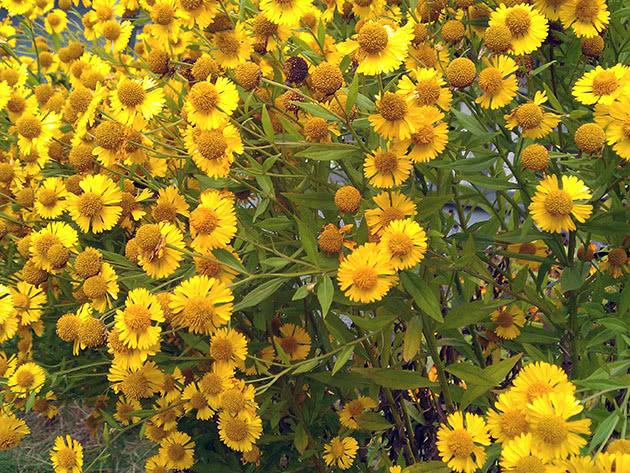
Flowering of helenium grown from seeds begins after 2 years of the growing season.
Care
For lush flowering, it is necessary to follow the rules of flower care: monitor watering, feed, loosening the soil, spraying against pests and diseases, pruning.
Watering
In temperate climates, helenium is watered every week. 2-3 liters of water are consumed per plant. Water is used previously settled or collected in the spring. In an arid climate, watering is increased up to 2 times a week, and with frequent rains, it is kept up to 1 time in 2 weeks.
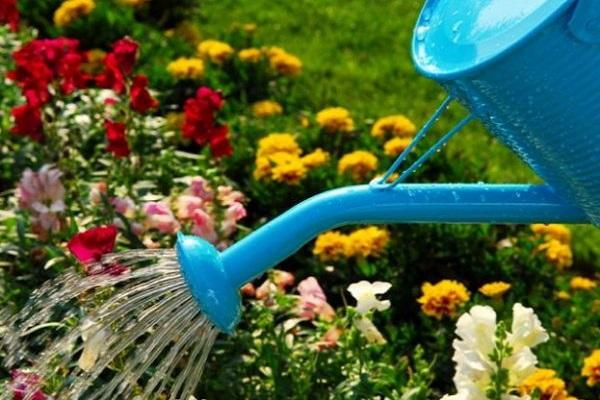
Loosening and weeding
Loosening is carried out after each watering and rain. The top layer of the soil is loosened with a hoe, while all weeds are removed. Weeds degrade the quality of the soil and absorb some of the minerals, depleting the soil. If you do not do regular weeding, this will affect the quality of flowering. Loosening and weeding enrich the plant roots with oxygen.
Top dressing
Top dressing of gelenium is carried out 3 times per season, the first at the beginning of the season, after planting or the appearance of the first shoots, the second during flowering, and the third after collecting seeds and preparing for wintering.

In May
In May, mineral fertilizers with a high nitrogen content are applied. Nitrogen improves flowering and accelerates plant growth and development.
Important! Excessive application of nitrogen to the soil negatively affects the development of the plant.
During flowering
During flowering, the helenium needs feeding, as the plant spends a lot of energy on the formation of buds and flowers. Use mineral complexes containing phosphorus, potassium, copper.
You can use wood ash.
At the end of October
At the end of October, seeds are formed on the shoots. After collecting seeds and pruning, complex mineral fertilizers are applied containing nitrogen, phosphorus, potassium. They are applied dry, during the winter mineral substances are absorbed into the soil, and by the spring they are absorbed by the plant.
Spraying
To prevent the development of diseases and attacks of pests, prophylactic treatment of bushes with insecticides and fungicides is carried out. The solutions are sprayed in dry, calm weather. Processing is carried out at the beginning of the growing season, before flowering.
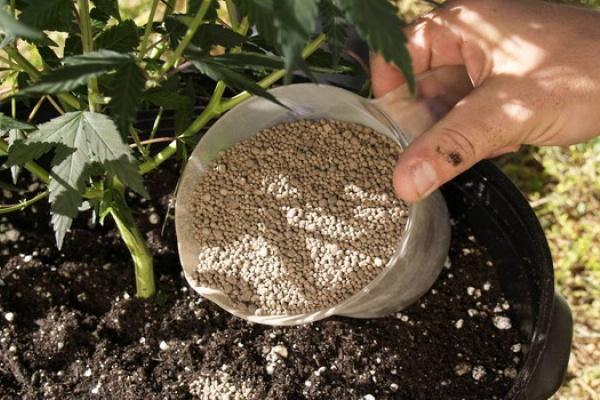
Topping
At the beginning of flowering, the lateral shoots are pinched, this procedure gives abundant flowering. Instead of spending energy on the formation of shoots, the plant will switch to the formation of flowers.
Transfer
Gelenium depletes the soil, so it must be replanted every 3-4 years. For this, a suitable new place is chosen, fertilized. The transplant is carried out in the spring, before flowering begins. At this time, you can propagate the bushes by dividing.
Diseases and pests
Gelenium has strong immunity, the flower is resistant to fungal diseases and insect attacks. However, if the growing and planting conditions are not followed, a chrysanthemum nematode attacks the flower. These are small worms that penetrate the roots of the plant, into the buds. It affects all parts of the plant. To combat them, they are treated with a chemical insecticide and the roots are watered with hot water. All affected areas of the flower are cut and burned.

Pruning inflorescences
Gelenium gives inflorescences gradually. Some are already fading, while others are in a bud state. It is recommended to cut off wilted and dying flowers, this accelerates the formation of new flowers.
After flowering
After flowering, the seeds are collected and the plant is covered for the winter.
Collection and storage of seeds
The flowering culture ends in September. By October, seeds ripen in the outlets. The flower petals dry up and fall off, and seeds form in the center. They dry out and can be easily removed from the socket. Grains are stored in gauze bags or a cardboard box, paper envelopes are also suitable for this purpose. Store seeds in a dry, warm place. Germination is maintained for 2-3 years after harvest.
Wintering
Many types of helenium are frost-resistant. Certain species and varieties do not tolerate severe frosts well. At the end of the season, the shoots of the plant are cut and the root area is mulched with moss, straw or sawdust. This will ensure the safety of the plant until the next season.
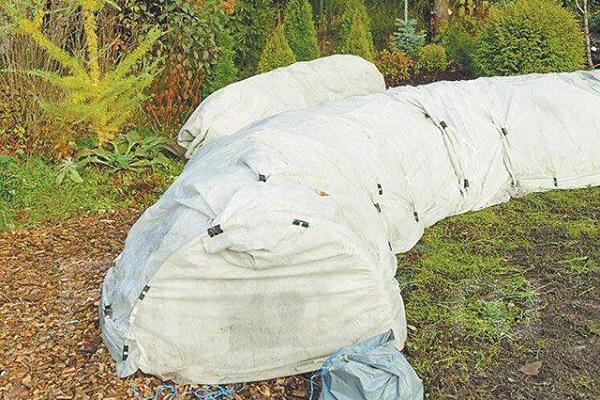
Kinds
Gelenium has many varieties. Gardeners most often grow 6 varieties, they easily endure winter and delight with their color and lush flowering.
Bigelow
The height of the shoots is about 80 cm, the leaves are straight lanceolate. Flowering falls in June-July. Flowers 5 cm in diameter, yellow-orange. The central part of the flower is brown.

Spring
Stems are dense, straight, up to 1 meter high. Covered with lanceolate green leaves. It begins to bloom in May and forms orange-yellow rosettes up to 7 cm in diameter.
Gupesa
It is popular with flower growers, the shoots are dense, lignified, up to 1.5 meters in height. The leaves are lanceolate, green. Flowers with a diameter of 3 to 5 cm are red-yellow in color. The plant blooms for 2 months.
Autumn
It is the founder of most varieties of helenium. Reaches a height of 2 meters. The stems are tall and dense. At the top are flowers with a diameter of 5-6 cm, bright orange color, with red thin lines and a yellow rim.
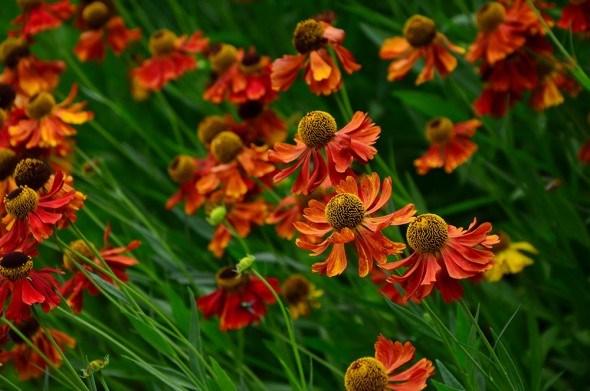
Hybrid
Plant height from 1 to 1.3 meters. The varieties have various colors: from light yellow to bright burgundy. Flowers 3-3.5 cm in diameter. Abundant flowering occurs in July.
Hupa
It takes root well on slopes and rocky areas.The plant reaches a height of 60-70 cm, bright yellow flowers are located at the top. Up to 10 cm in diameter.
Popular varieties
Gelenium varieties are bred from autumn species. He is the progenitor of almost all varieties. Hybrid varieties are less resistant to cold weather.
Important! The seeds of the hybrid varieties do not produce these colors. For cultivation through seeds, they are purchased in stores.

Rubintswerg
Cold-resistant low-growing variety, grows up to 60 cm in height. Flowers are bright red, burgundy. Flowering lasts 4 months.
Cockade
Hybrid variety, shoots reach 120 cm in height, red-brown flowers with a yellow-brown convex center are located at the top.
Moorheim Beauty
Plant height reaches 90-120 cm. A distinctive feature of the variety is flowering with rosettes of different colors: yellow, red, orange.
Blooms from July to November.
Waltraud
Hybrid variety, shoots about 80 cm in height, forms flowers of yellowish copper color with a brownish yellow center. Blooms from July to August.
Koenigstiger
High shoots, up to 150 cm, forms bright yellow flowers with a burgundy border. The middle is brown-burgundy. Blooms from July to September.

Baudirektor linne
The height of the bush is 1.3 meters. At the top are bright maroon flowers. The middle is brownish red. Blooms in August.
Sonnewunder
A medium-sized variety of helenium, the height of the shoots is up to 90 cm. It forms bright yellow-orange flowers with a diameter of 4 cm. Flowering begins in the middle of the season.
September gold
The height of the shoots is 1 meter. The flowers are bright yellow in color with the same center. Leaves are green lanceolate. Blooms in September.
Katarina
The height of the shoots is up to 1.5 meters, the color of the flowers is bright orange-red. Leaves are green lanceolate. Flowers with a diameter of 5 cm.
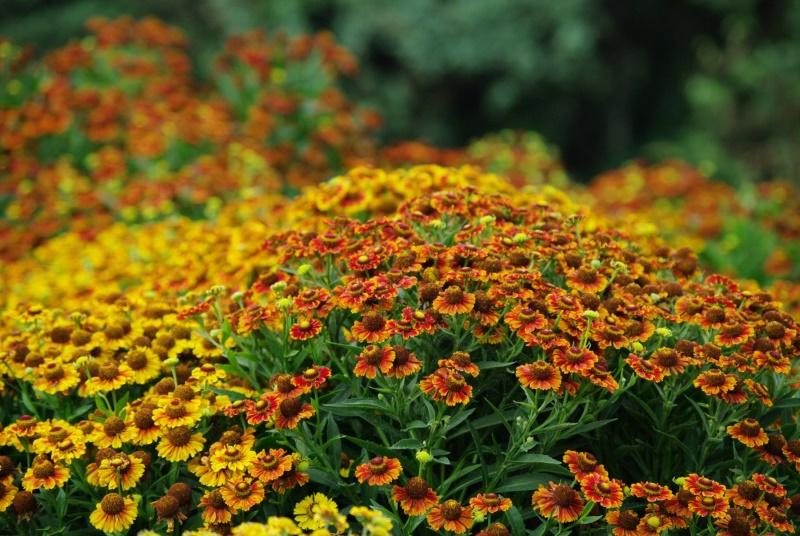
Superboom
The stems are 1.8 meters high. The flowers are yellow-orange, the petals are wavy at the edges. The leaves are dark green, lanceolate.
Altgold
The bushes reach 90 cm in height, bloom with golden-brown flowers up to 4 cm in diameter. The core is large, brown-purple.
Goldfuchs
The plant is up to 1.8 meters high, forms brown-orange flowers with yellow spots. Blooms in August.
Dee Blonde
Plant height up to 1.7 meters. Forms bright red flowers with a diameter of 6-8 cm. The core is convex, yellow-brown. Blooms from July to September.

Glutauge
Medium-sized variety of helenium. Coral flowers, yellow-red core. The diameter of the flowers is 4 cm. It blooms in the middle of summer.
Reproduction
The plant reproduces in two ways: by seed and by division.
Seeds
The seeds of the plant are planted for seedlings in March, then transferred to open ground. The annual plant does not bloom, the first flowers form in one season.

By dividing the bush
The mother bush is dug out, being careful not to damage the roots. Then the roots are cut into several pieces with scissors or a knife and planted in separate holes. Helenium rejuvenation is carried out every 3-4 years.
Use in landscape design
Due to its lush bloom, it is preferable to plant Gelenium in flower beds, on lawns, along borders, next to bushy plants. Tall varieties are planted in the background flower beds, and undersized ones in front of them.


